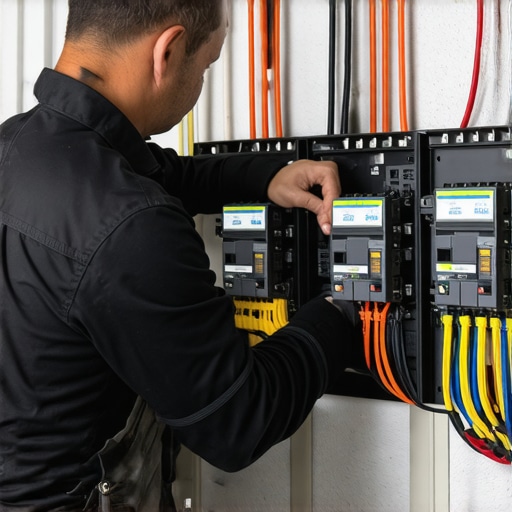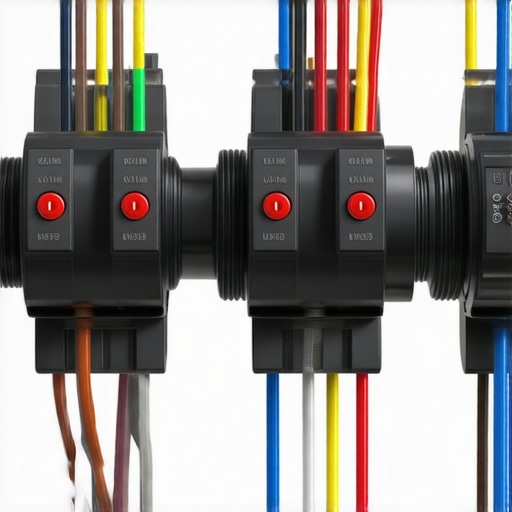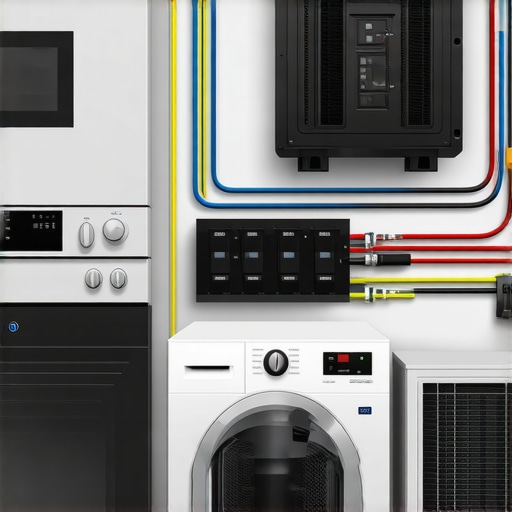My Journey into Electrical Wiring: Why Dedicated Circuits Matter
As someone passionate about home improvement, I vividly remember the first time I attempted to install a new high-power appliance. The thrill of upgrading my kitchen was quickly overshadowed by a nagging concern about electrical safety. That experience ignited my quest to understand the importance of dedicated circuits for high-power home appliances, and I want to share some insights from my personal journey.
Understanding the Basics: What Are Dedicated Circuits?
In my early DIY days, I learned that dedicated circuits are specialized electrical paths designed solely for high-demand appliances like ovens, dryers, or HVAC systems. Unlike shared circuits, these dedicated lines prevent overloads, reduce tripping breakers, and enhance safety. According to [Electrical Safety Foundation International](https://www.esfi.org), proper circuit design is key to preventing electrical fires and equipment damage.
Getting Started: Planning Your Electrical Wiring Project
My first step was always thorough planning. I measured the load requirements of my appliances and mapped out the circuit layouts. I discovered that using a dedicated circuit involved selecting the right wire gauge—usually 10 or 12-gauge wire for high-power devices—and installing a circuit breaker tailored to the appliance’s needs. I also realized that understanding your home’s electrical panel is crucial before making any modifications.
Step-by-Step: Installing a Dedicated Circuit
Here is a simplified overview of my experience installing a dedicated circuit:
- Turn off the main power supply for safety.
- Run the appropriate gauge wire from the electrical panel to the appliance location.
- Install a dedicated circuit breaker in your breaker box.
- Connect the wiring securely to the breaker and the outlet or terminal box of the appliance.
- Double-check all connections, turn the power back on, and test the appliance.
Remember, if you’re unsure about any step, consulting a licensed electrician is always the safest choice. You can find detailed guides at [DIY Projects for Beginners](https://en.diykutak.com/diy-projects-for-beginners-creative-solutions-for-your-home).
What Are the Hidden Risks of Ignoring Dedicated Circuits?
One thing I’ve learned through experience is that neglecting proper wiring can lead to serious issues like frequent breaker trips, overheating wires, or even electrical fires. The National Fire Protection Association emphasizes the importance of adhering to electrical codes to prevent hazards. So, investing time in proper wiring is not just about convenience—it’s about safety.
If you’re considering this project, I recommend exploring my other DIY ideas that can complement your electrical work, such as installing smart home thermostats or building custom cabinets for better organization.
Feel free to share your own experiences or ask questions in the comments below—I love hearing about fellow DIY enthusiasts’ journeys!
Why Choosing the Right Wiring Methods Can Elevate Your DIY Projects
Building on my previous insights about dedicated circuits, I want to delve deeper into the nuances of electrical wiring techniques that can make a significant difference in your home projects. Proper wiring isn’t just about safety; it influences the longevity of your appliances and the overall efficiency of your electrical system. Understanding the subtleties of wire types, protective devices, and installation practices can help you avoid common pitfalls and ensure your DIY endeavors stand the test of time.
Harnessing the Power of Proper Wiring Techniques
One crucial aspect I learned early on is selecting the correct wire gauge. For most high-demand appliances, 10 or 12-gauge wire is standard, but in some cases, heavier gauge wiring might be necessary to prevent overheating. Using the right wire gauge ensures that your system can handle the load safely, preventing electrical fires or equipment failures. The National Electrical Code (NEC) provides comprehensive guidelines on wire sizing and circuit protection, which I highly recommend studying before starting any wiring project. For a detailed understanding, you can explore trusted resources like this guide on home wiring essentials.
Implementing Advanced Safety Measures
Beyond wire size, incorporating safety devices such as ground-fault circuit interrupters (GFCIs) and arc-fault circuit interrupters (AFCIs) can dramatically reduce risks associated with electrical faults. GFCIs are essential in areas prone to moisture, like kitchens and bathrooms, while AFCIs help prevent fires caused by arc faults in wiring. As I gained experience, I realized that integrating these devices into your wiring plan not only complies with safety standards but also provides peace of mind. Proper installation of these safety features requires attention to detail—something I mastered through practice and continuous learning, including consulting experienced electricians or authoritative sources.
Practical Tips for Seamless Wiring Installation
In my projects, I always emphasize meticulous planning. Drawing detailed schematics, marking circuit loads, and double-checking connections before energizing the system are steps I swear by. Using quality connectors and ensuring tight, corrosion-resistant connections are vital for durability. When working in tight or complex spaces, employing flexible conduit and cable management solutions can save you time and avoid future complications. For those interested in expanding their skills, I recommend exploring advanced guides like step-by-step wiring tutorials.
How Can You Future-Proof Your Home’s Electrical System?
As technology evolves, so do our power needs. Planning for future upgrades—such as additional appliances, smart home devices, or renewable energy integrations—is a key consideration. Installing extra circuits or conduit pathways during initial wiring can save significant effort later. Also, choosing versatile circuit breakers and incorporating dedicated circuits for upcoming appliances ensures your system remains robust and adaptable. Considering these factors during your DIY projects reflects not just expertise but foresight, aligning with the best practices shared by industry professionals.
For more insights into innovative DIY solutions that complement electrical projects, check out smart DIY ideas for modern living. If you have questions or want to share your experiences, don’t hesitate to leave a comment or reach out through our contact page. Sharing your journey can inspire others and foster a community of skilled DIY enthusiasts!
Embracing Complexity: Why Advanced Wiring Matters for Your Home’s Longevity
When I first started tackling electrical projects, I believed that simple wiring was enough to keep my home safe and functional. Over time, I realized that investing in advanced wiring techniques—like proper conduit management, sophisticated circuit protection, and strategic load balancing—not only enhances safety but also prepares your home for future upgrades. These nuances, often overlooked by DIYers, can make a significant difference in the durability and efficiency of your electrical system.
Deep Dive: How Proper Conduit Management Can Prevent Future Headaches
One of the most overlooked aspects I encountered was conduit organization. Using flexible, corrosion-resistant conduit and thoughtful routing minimizes interference, reduces wear, and simplifies future repairs or modifications. I learned that planning conduit pathways during initial wiring saves hours of work later and reduces risks of accidental damage or shorts. For example, running separate conduit lines for different circuits ensures that if one needs maintenance, it won’t disrupt the entire system. For detailed guidance, I recommend exploring step-by-step conduit installation tutorials.
Why Circuit Load Balancing Is a Game-Changer in Electrical Safety
Balancing circuit loads across multiple breakers is an advanced concept I adopted after experiencing frequent breaker trips that seemed inexplicable. Distributing high-demand appliances—like HVAC systems, ovens, or water heaters—across dedicated circuits prevents overloads and prolongs equipment life. This approach also mitigates the risk of wiring overheating, which can cause fires. I found that understanding the total load calculations, as outlined by the NEC, helps in designing a safer, more resilient system. For those interested, my article on dedicated circuits for high-power appliances offers valuable insights into load management.

Advanced Safety Devices: Going Beyond the Basics
In my experience, integrating devices like arc-fault circuit interrupters (AFCIs) and advanced GFCIs significantly elevates home safety. AFCIs detect dangerous arc faults that traditional breakers often miss, preventing potential fires. Modern GFCIs, with their rapid response times, protect against ground faults in areas prone to moisture. Installing these devices requires understanding their specific wiring requirements—something I mastered through hands-on practice and consultation with professionals. The investment in these safety features pays off by providing peace of mind and compliance with evolving safety standards.
Thinking Ahead: Planning Your Electrical System for Future Technologies
Technology evolves rapidly, and I learned the importance of future-proofing my electrical system during initial wiring. Installing extra circuits, conduit pathways, and versatile breaker panels allows for seamless upgrades—be it smart home integrations, solar power, or additional appliances. For example, dedicating space in your electrical panel for future breakers can save significant effort and cost later. This foresight aligns with industry best practices, as highlighted in my guide on advanced wiring planning for modern homes. By thinking ahead, you create a resilient system that adapts to your needs over time.
Sharing your experiences or asking questions about complex wiring techniques can inspire others and deepen our collective understanding. Feel free to comment below or explore related projects like building space-saving electrical fixtures to complement your wiring skills.
Harnessing the Power of Strategic Load Management
One of the most sophisticated aspects I’ve integrated into my electrical projects is load balancing, a technique that ensures each circuit bears an appropriate load to prevent overloads and prolong system lifespan. By carefully distributing appliances across dedicated circuits, I’ve minimized breaker trips and enhanced overall safety. This approach requires meticulous calculation of each device’s amperage and understanding the National Electrical Code’s guidelines, which provide a framework for designing resilient electrical systems. Proper load management not only improves safety but also optimizes energy consumption, saving costs in the long run. To deepen your understanding, exploring resources like the NEC standards is invaluable for informed decision-making.
Innovating with Conduit Management for Future-Proofing
Conduit organization is an often underestimated element that can dramatically influence the durability and maintainability of your wiring. I advocate for using flexible, corrosion-resistant conduit systems that allow for seamless upgrades and repairs. Strategic routing—such as separating circuits in different conduits—reduces interference and simplifies troubleshooting. During my projects, I plan conduit pathways with future expansions in mind, providing extra capacity and accessible junction points. This foresight ensures that adding new circuits or modifying existing ones doesn’t become a logistical nightmare. For comprehensive guidance, I recommend reviewing tutorials on conduit installation techniques that embrace scalability and safety.
What Are the Critical Safety Devices That Elevate Home Electrical Systems?
Beyond standard circuit breakers, integrating advanced safety devices like arc-fault circuit interrupters (AFCIs) and ground-fault circuit interrupters (GFCIs) is crucial for modern electrical safety. AFCIs help detect dangerous arc faults that can ignite fires, while GFCIs protect against ground faults, especially in moisture-prone areas. Installing these devices requires careful wiring and adherence to manufacturer specifications, but the peace of mind they offer is well worth the effort. My experience has taught me that upgrading older systems with these safety features significantly reduces fire risks and enhances compliance with evolving safety standards. For in-depth installation tips, consulting authoritative resources like the OSHA electrical safety guidelines is beneficial.
Future-Proofing Your Home’s Electrical Infrastructure
Anticipating future technological needs is a hallmark of a truly professional wiring plan. During my projects, I’ve incorporated extra circuits, conduit pathways, and versatile breaker panels to accommodate smart home devices, solar integrations, and additional appliances. Dedicating space for future expansion not only saves time and money but also ensures your system remains adaptable and resilient. An example is installing conduit loops or junction boxes at strategic points, allowing for straightforward upgrades without invasive rewiring. This proactive planning aligns with industry best practices and positions your home for seamless technological integration. For inspiration, explore articles on smart home wiring innovations.
How Can Deep Expertise in Wiring Techniques Transform Your DIY Projects?
Mastering advanced wiring techniques transforms your DIY capabilities from basic to professional-grade. Techniques such as strategic conduit management, load balancing, and installing sophisticated safety devices elevate your projects’ safety, durability, and efficiency. I’ve found that continuous learning—through authoritative guides and hands-on practice—enables me to troubleshoot complex issues and implement innovative solutions confidently. Sharing these insights not only enhances community knowledge but also inspires others to pursue higher standards in their home improvements. If you’re eager to expand your skills, I encourage you to explore detailed tutorials and expert advice available on comprehensive DIY guides.
< >
>
Things I Wish I Knew Earlier (or You Might Find Surprising)
1. The Hidden Power of Proper Circuit Planning
Looking back, I realize how much smoother my projects went when I took the time to map out my electrical system carefully. Rushing into wiring without a plan often led to confusion and the need for rework. A detailed schematic not only saves time but also minimizes errors, especially when installing dedicated circuits for high-demand appliances.
2. The Surprising Importance of Load Balancing
Initially, I underestimated how critical load balancing was. Distributing appliances across multiple circuits prevented frequent breaker trips and protected my wiring from overheating. Learning to calculate amperage and plan load distribution truly transformed my approach to home wiring.
3. Advanced Safety Devices Are Worth Every Penny
Adding AFCIs and GFCIs to my system significantly increased my peace of mind. These devices caught potential faults early, preventing dangerous situations. Upgrading older panels with these safety features was a game-changer in my home safety strategy.
4. Conduit Management Saves Future Hassles
Organizing conduits with future expansion in mind made later upgrades effortless. Running separate conduits for different circuits and using flexible, corrosion-resistant materials ensured durability and easy troubleshooting down the line.
5. Future-Proofing Your Home During Initial Wiring
Thinking ahead by installing extra circuits and conduit pathways meant I could easily add new appliances or smart home devices later. This proactive approach saved me time and costs, making my home more adaptable for future technologies.
6. Continual Learning Is Key
I found that consulting trusted resources like the NEC guidelines and reputable DIY guides kept me updated on best practices. Staying informed helped me avoid common pitfalls and ensured my projects met safety standards.
Resources I’ve Come to Trust Over Time
- National Electrical Code (NEC)—Essential for understanding wire sizing, load calculations, and safety standards. It’s my go-to reference for any serious wiring project.
- Electrical Safety Foundation International (ESFI)—Offers comprehensive safety tips and guidelines that I always review before starting new projects.
- DIY Projects for Beginners—A fantastic resource with step-by-step guides that helped me learn the basics and refine my skills.
- OSHA Electrical Safety Guidelines—Provides detailed safety procedures that I adhere to strictly, especially when working on live systems.
Parting Thoughts from My Perspective
Reflecting on my journey with electrical wiring, I realize that understanding dedicated circuits and advanced safety measures has been vital for creating a safe, efficient, and future-ready home. It’s tempting to cut corners, but investing time in proper planning, load balancing, and safety device installation truly pays off in peace of mind and durability. If you’re interested in home improvement or DIY wiring, I encourage you to keep learning, stay curious, and never hesitate to consult professionals when needed. Your home’s electrical system is the backbone of your daily life, so treat it with care and respect. If this resonated with you, I’d love to hear your thoughts or experiences—drop a comment below or explore more at DIY Projects for Beginners. Happy wiring!

